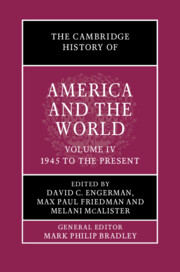Book contents
- The Cambridge History of America and the World
- The Cambridge History of America and the World
- The Cambridge History of America and the World
- Copyright page
- Contents
- Figures
- Maps
- Contributors to Volume IV
- General Introduction: What is America and the World?
- Introduction to Volume IV
- Part I Ordering a World of States
- Part II Challenging a World of States
- Part III New World Disorder?
- 23 The Illusions of the United States’ Great Power Politics after the Cold War
- 24 Neoliberalism as a Form of US Power
- 25 The US Construction of “Islam” as Ally and Enemy on the Global Stage
- 26 Technology and Networks of Communication
- 27 Humanitarian Intervention and US Power
- 28 Refugees, Statelessness, and the Disordering of Citizenship
- 29 Liberty, Security, and America’s War on Terror
- 30 The Global Wars on Terror
- 31 America and the World in the Anthropocene
- Index
25 - The US Construction of “Islam” as Ally and Enemy on the Global Stage
from Part III - New World Disorder?
Published online by Cambridge University Press: 12 November 2021
- The Cambridge History of America and the World
- The Cambridge History of America and the World
- The Cambridge History of America and the World
- Copyright page
- Contents
- Figures
- Maps
- Contributors to Volume IV
- General Introduction: What is America and the World?
- Introduction to Volume IV
- Part I Ordering a World of States
- Part II Challenging a World of States
- Part III New World Disorder?
- 23 The Illusions of the United States’ Great Power Politics after the Cold War
- 24 Neoliberalism as a Form of US Power
- 25 The US Construction of “Islam” as Ally and Enemy on the Global Stage
- 26 Technology and Networks of Communication
- 27 Humanitarian Intervention and US Power
- 28 Refugees, Statelessness, and the Disordering of Citizenship
- 29 Liberty, Security, and America’s War on Terror
- 30 The Global Wars on Terror
- 31 America and the World in the Anthropocene
- Index
Summary
The US’s relationship to “Islam” – that is Islam as a construct rather than a reflection of the religion and its adherents – is contradictory. In Covering Islam, Edward Said argued that “Islam,” as a part fictional and part ideological designation, is not only based on “patent inaccuracy” but also “unrestrained ethnocentrism.” While Said focused on the racial and cultural hatred of the Muslim “other” produced in the West by cultural thinkers, experts, journalists, and policymakers, this analysis explores both racialized constructs and glorified ones. In both cases, these constructions are ethnocentric in that they represent (and help to construct) a narrow understanding that tends to prioritize US geopolitical interests. While policymakers set the terms of discussion and are the “primary definers” of a topic, cultural products, from films to news stories, also play a role in shaping how state policy is defined. Further, culture can also provide, on rare occasions, an opportunity to address American policies critically.
- Type
- Chapter
- Information
- The Cambridge History of America and the World , pp. 586 - 607Publisher: Cambridge University PressPrint publication year: 2022



